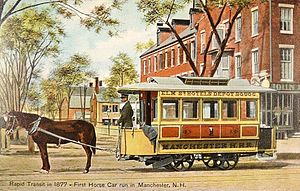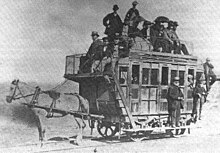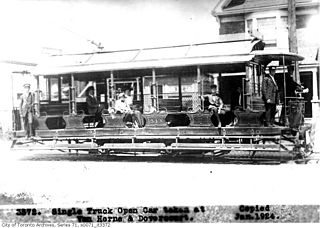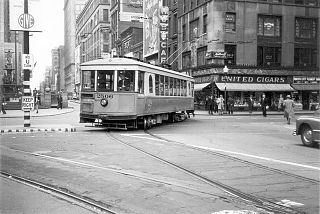
A horsecar, horse-drawn tram, horse-drawn streetcar (U.S.), or horse-drawn railway (historical), is an animal-powered (usually horse) tram or streetcar.

A horsecar, horse-drawn tram, horse-drawn streetcar (U.S.), or horse-drawn railway (historical), is an animal-powered (usually horse) tram or streetcar.

The horse-drawn tram (horsecar) was an early form of public rail transport, which developed out of industrial haulage routes that had long been in existence, and from the omnibus routes that first ran on public streets in the 1820s[ citation needed ], using the newly improved iron or steel rail or 'tramway'. They were local versions of the stagecoach lines and picked up and dropped off passengers on a regular route, without the need to be pre-hired. Horsecars on tramlines were an improvement over the omnibus, because the low rolling resistance of metal wheels on iron or steel rails (usually grooved from 1852 on) allowed the animals to haul a greater load for a given effort than the omnibus, and gave a smoother ride. The horse-drawn streetcar combined the low cost, flexibility, and safety of animal power with the efficiency, smoothness, and all-weather capability of a rail track. Animal power at the time was seen as safer than steam power in that early locomotives frequently suffered from boiler explosions. Rails were seen as all-weather because streets of the time might be poorly paved, or not paved at all, allowing wagon wheels to sink in mud during rain or snow.
In 1861, Toronto Street Railway horsecars replaced horse-drawn omnibuses as a public transit mode in Toronto. Electric streetcars later replaced the horsecars between 1892 and 1894. The Toronto Street Railway created Toronto's unique broad gauge of 4 ft 10+7⁄8 in (1,495 mm). The streets were unpaved, and a step rail was employed. The horsecars had flanged wheels and ran on the upper level of the step. Ordinary wagons and carriages ran on the broad lower step inside. This necessitated a wider gauge. This broad Toronto gauge is still used today by the Toronto streetcar system and three lines of the Toronto subway. [1] The Metropolitan Street Railway operated a horsecar line in then-suburban North Toronto from 1885 until the line was electrified in 1890; this horsecar line also used Toronto gauge. [2]
The first horse-drawn trams in India ran a 2.4-mile (3.9 km) distance between Sealdah and Armenian Ghat Street on 24 February 1873. The service was discontinued on 20 November of that year. [3] The Calcutta Tramway Company was formed and registered in London on 22 December 1880. Metre-gauge horse-drawn tram tracks were laid from Sealdah to Armenian Ghat via Bowbazar Street, Dalhousie Square and Strand Road. The route was inaugurated by Viceroy Ripon on 1 November 1880. [3] In 1882, steam locomotives were deployed experimentally to haul tram cars. By the end of the 19th century the company owned 166 tram cars, 1000 horses, seven steam locomotives and 19 miles of tram tracks. [3] In 1900, electrification of the tramway and reconstruction of its tracks to 4 ft 8+1⁄2 in (1,435 mm) (standard gauge) began. [3] In 1902, the first electric tramcar in India ran from Esplanade to Kidderpore on 27 March and on 14 June from Esplanade to Kalighat.
The Bombay Tramway Company was set up in 1873. After a contract was signed between the Bombay Tramway Company, the municipality and the Stearns and Kitteredge company, the Bombay Presidency enacted the Bombay Tramways Act, 1874 licensing the company to run a horsecar tram service in the city. [4] On 9 May 1874 the first horse-drawn carriage made its début in the city, plying the Colaba–Pydhone via Crawford Market, and Bori Bunder to Pydhonie via Kalbadevi routes. The initial fare was three annas (15 paise pre-decimalisation), and no tickets were issued. As the service became increasingly popular, the fare was reduced to two annas (10 pre-decimalisation paise). Later that year, tickets were issued to curb increasing ticket-less travel. [5] Stearns and Kitteredge reportedly had a stable of 1,360 horses over the lifetime of the service. [6]


The first tram services in the world were started by the Swansea and Mumbles Railway in Wales, using specially designed carriages on an existing tramline built for horse-drawn freight dandies. Fare-paying passengers were carried on a line between Oystermouth, Mumbles and Swansea Docks from 1807. The Gloucester and Cheltenham Tramroad (1809) carried passengers although its main purpose was freight.
In spite of its early start, it took many years for horse-drawn streetcars to become widely acceptable across Britain; the American George Francis Train first introduced them to Birkenhead Corporation Tramways' predecessor in Birkenhead in 1860 but was jailed for "breaking and injuring" the highway when he next tried to lay the first tram tracks on the roads of London. An 1870 Act of Parliament overcame these legal obstacles by defining responsibilities and for the next three decades many local tramway companies were founded, using horse-drawn carriages, until replaced by cable, steam or electric traction. Many companies adopted a design of a partly enclosed double-decker carriage hauled by two horses. The last horse-drawn tram was retired from London in 1915. Horses continued to be used for light shunting well into the 20th century. The last horse used for shunting on British Railways was retired on 21 February 1967 in Newmarket, Suffolk.
In the United States the very first streetcar appeared in New Orleans in 1832, operated by the Pontchartrain Railroad Company, followed by those in 1832 on the New York and Harlem Railroad in New York City. [7] The latter cars were designed by John Stephenson of New Rochelle, New York, and constructed at his company in New York City. The earliest streetcars used horses and sometimes mules, usually two as a team, to haul the cars. Rarely, other animals were tried, including humans in emergency circumstances. By the mid-1880s, there were 415 street railway companies in the US operating over 6,000 miles (9,700 km) of track and carrying 188 million passengers per year using horsecars. By 1890 New Yorkers took 297 horsecar rides per capita per year. The average street car horse had a life expectancy of about two years. [8]
The first horse-drawn rail cars on the Continental Europe were operated from 1828 by the České Budějovice - Linz railway. Europe saw a proliferation of horsecar use for new tram services from the mid-1860s, with many towns building new networks.
Tropical plantations (for products such as henequen and bananas) made extensive use of animal-powered trams for both passengers and freight, often employing the Decauville narrow-gauge portable track system. In some cases these systems were very extensive and evolved into interurban tram networks (as in the Yucatan, which sported over 3,000 kilometers (1,900 mi) of such lines). Surviving examples may be found in both the Yucatan [9] and Brazil. [10]
Problems with horsecars included the fact that any given animal could only work so many hours on a given day, had to be housed, groomed, fed and cared for day in and day out, and produced prodigious amounts of manure, [8] which the streetcar company was charged with storing and then disposing. Since a typical horse pulled a streetcar for about a dozen miles (19 km) a day and worked for four or five hours, many systems needed ten or more horses in stable for each horsecar.
Horsecars were largely replaced by electric-powered streetcars following the invention by Frank J. Sprague of an overhead trolley system on streetcars for collecting electricity from overhead wires. His spring-loaded trolley pole used a wheel to travel along the wire. In late 1887 and early 1888, using his trolley system, Sprague installed the first successful large electric street railway system in Richmond, Virginia. Long a transportation obstacle, the hills of Richmond included grades of over 10%, and were an excellent proving ground for acceptance of the new technology in other cities. Within a year, the economy of electric power had replaced more costly horsecars in many cities. By 1889, 110 electric railways incorporating Sprague's equipment had been begun or planned on several continents.
Many large metropolitan lines lasted well into the early twentieth century. New York City had a regular horsecar service on the Bleecker Street Line until its closure in 1917. [11] Pittsburgh, Pennsylvania, had its Sarah Street line drawn by horses until 1923. The last regular mule-drawn cars in the US ran in Sulphur Rock, Arkansas, until 1926 and were commemorated by a U.S. postage stamp issued in 1983. [12] Toronto's horse-drawn streetcar operations ended in 1891. [13] In other countries animal-powered tram services often continued well into the 20th century; the last mule tram service in Mexico City ended in 1932, and a mule tram in Celaya, Mexico, survived until 1954. [14]
A few original horsecar lines have survived or have been revived as tourist attractions, and in recent years several replica horsecar lines have been built. Below is a list of locations around the world with operational horsecars that are open to the public.

A tram is a type of urban rail transit consisting of a rail vehicle, either individual railcars or self-propelled trains coupled by a multiple unit, that runs on tramway tracks on urban public streets; some include segments on segregated right-of-way. The tramlines or networks operated as public transport are called tramways or simply trams/streetcars. Many recently built tramways use the contemporary term light rail.

The interurban is a type of electric railway, with tram-like electric self-propelled rail cars which run within and between cities or towns. The term "interurban" is usually used in North America, with other terms used outside it. They were very prevalent in many parts of the world before the Second World War and were used primarily for passenger travel between cities and their surrounding suburban and rural communities. Interurban as a term encompassed the companies, their infrastructure, their cars that ran on the rails, and their service. In the United States, the early 1900s interurban was a valuable economic institution, when most roads between towns, many town streets were unpaved, and transportation and haulage was by horse-drawn carriages and carts.

The PCC is a tram design that was first built in the United States in the 1930s. The design proved successful domestically, and after World War II it was licensed for use elsewhere in the world where PCC based cars were made. The PCC car has proved to be a long-lasting icon of streetcar design, and many remain in service around the world.

The Toronto Street Railway (TSR) was the operator of a horse-drawn streetcar system from 1861 to 1891 in Toronto, Ontario, Canada. Its successor, the Toronto Railway Company, inherited the horsecar system and electrified it between 1892 and 1894.

The Toronto Railway Company (TRC) was the operator of the streetcar system in Toronto between 1891 and 1921. It electrified the horsecar system it inherited from the Toronto Street Railway, the previous operator of streetcar service in Toronto. The TRC was also a manufacturer of streetcars and rail work vehicles, a few of which were built for other streetcar and radial operators.
Trams in India were established in the late 19th century. Horse-drawn trams were introduced in Kolkata in 1873; in Mumbai, trams began operations in 1874; in Nashik in 1889; electric trams began in Chennai in 1895, and trams were also introduced in Kanpur and Delhi. They were discontinued in all Indian cities between 1933 and 1964, except for Kolkata.

The Denver Tramway, operating in Denver, Colorado, was a streetcar system incorporated in 1886. The tramway was unusual for a number of reasons: the term "tramway" is generally not used in the United States, and it is not known why the company was named as such. The track was 3 ft 6 in narrow gauge, an unusual gauge in the United States, but in general use by railways in Japan, southern Africa, New Zealand, and Queensland, Australia.

Trams in Saint Petersburg are a major mode of public transit in the city of Saint Petersburg, Russia. Saint Petersburg once had the second-largest tram network in the world, consisting of about 340 kilometres (210 mi) of unduplicated track in the late 1980s. However, since 1995 the tramway network has declined sharply in size as major portions of track were removed, particularly in the city centre. Saint Petersburg lost its record to Melbourne, Australia. While it still had 285 kilometres (177 mi) of length in 2002, by early 2007 the tram network's had declined to just over 220 kilometres (140 mi), and by the 2010s operated on just 205.5 kilometres (127.7 mi) of network.

Streetcars or trolley(car)s were once the chief mode of public transit in hundreds of North American cities and towns. Most of the original urban streetcar systems were either dismantled in the mid-20th century or converted to other modes of operation, such as light rail. Today, only Toronto still operates a streetcar network essentially unchanged in layout and mode of operation.
The history of trams, streetcars, or trolleys began in the early nineteenth century. It can be divided up into several discrete periods defined by the principal means of motive power used.

Although tram systems date to the late 19th and early 20th centuries, many old systems were closed during the mid-20th century because of the advent of automobile travel. This was especially the case in North America, but postwar reductions and shutdowns also occurred on British, French and other Western European urban rail networks. However, traditional tramway systems survived, and eventually even began to thrive from the late 20th century onward, some eventually operating as much as when they were first built over a century ago. Their numbers have been augmented by modern tramway or light rail systems in cities which had discarded this form of transport.
Ottawa Electric Railway Company was a streetcar public transit system in the city of Ottawa, Canada, part of the electric railway streetcars that operated between 1891 and 1959. Ottawa once had tracks through downtown on Rideau Street, Sparks Street and others, and extended outside of the downtown core to provide services that helped form communities such as Westboro, Old Ottawa South and The Glebe. Prior to this, starting in 1866, public transportation was provided by Ottawa City Passenger Railway Company, a horse-drawn tram service. The O.E.R. was taken over by the Ottawa Transportation Commission in 1948, which was itself succeeded by OC Transpo in 1973.

Streetcars operated by the Cincinnati Street Railway were the main form of public transportation in Cincinnati, Ohio, at the end of the 19th century and the start of the 20th century. The first electric streetcars began operation in 1889, and at its maximum, the streetcar system had 222 miles (357 km) of track and carried more than 100 million passengers per year. A very unusual feature of the system was that cars on some of its routes traveled via inclined railways to serve areas on hills near downtown. With the advent of inexpensive automobiles and improved roads, transit ridership declined in the 20th century and the streetcar system closed in 1951. Construction of a new streetcar system, now known as the Connector, began in 2012. Consisting initially of a single route, the new system opened on September 9, 2016.
Prior to 1959, Montreal, Quebec, Canada had an extensive streetcar system. The streetcar network had its beginnings with the horsecar era of the Montreal City Passenger Railway in 1861. The initial line was along Rue Notre Dame from Rue du Havre to Rue McGill.
Beginning operation in 1861, the Yonge streetcar line was the first streetcar line in Toronto and the first in Canada. It started off as a horsecar line and closed in 1954 operating two-unit trains of Peter Witt motors pulling a trailer. Under the Toronto Transportation Commission, the Yonge line was the busiest and most congested streetcar line in the city leading to its replacement in 1954 by the Yonge Subway line, also Toronto's first and the first in Canada.

Toronto-gauge railways are tram and rapid transit lines built to Toronto gauge, a broad gauge of 4 ft 10+7⁄8 in. This is 2+3⁄8 in (60 mm) wider than standard gauge of 4 ft 8+1⁄2 in which is by far the most common track gauge in Canada. The gauge is unique to the Greater Toronto Area and is currently used on the Toronto streetcar system and the Toronto subway, both operated by the Toronto Transit Commission. As well, the Halton County Radial Railway, a transport museum, uses the Toronto gauge so its rail line can accommodate its collection of Toronto streetcars and subway trains. Several now-defunct interurban rail systems also once used this gauge.

The tranvía was a streetcar system that served Manila and its surrounding cities during the early years of the 20th century.

The Quebec City tramway (1865–1948) was a streetcar system that started operations in 1865 with horsecars, electrified in 1897 and ceased operation in 1948. This former system is distinct from the proposed light-rail line, known as the Quebec City Tramway.
Chapter 1 - The Spinal Cord of Yonge Street